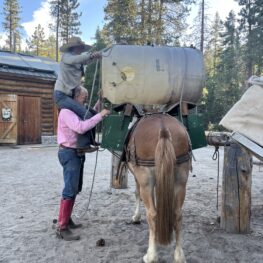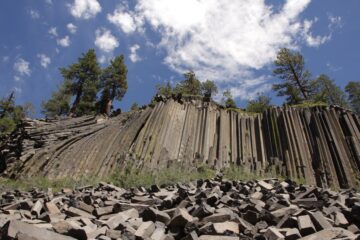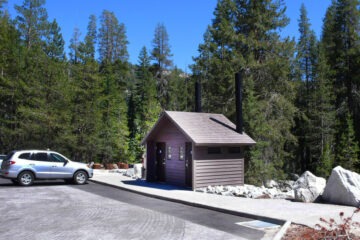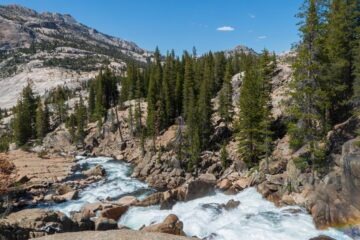This article appeared in our 2025 Spring/Summer Magazine. Read all our magazines here.
By Zoe Duerksen-Salm

Nick Aucker and Abby Adams are about as opposite as a pair could be. They are, as Nick says, “literally the biggest and smallest Yosemite packers” — Nick being over 6’4” compared with Abby’s 5’3”.
Nick cowboyed his way across the Southwest before settling in California, while Abby found her way from Kentucky through a degree in forestry. Nick is in his 60s and dreams of retiring in Costa Rica, while Abby is in her 30s and still in the early years of her career. And, unlike Abby, Nick always wears a pink shirt. “It’s the happiest color,” Nick says. “It makes me happy, and when I see people on the trail, it gives them a smile.”
As cliché as it gets, in this case opposites do attract. Over four summers, Nick and Abby have become best friends working side by side in Yosemite National Park as backcountry packers, trekking across the park’s wilderness with mules in tow to haul human waste out of the park. “They’re a package deal,” says friend and National Park Service ranger Kate Trust, referring to both their friendship and their work as packers.
Packing Waste
In the 1980s, long before Nick and Abby found their way to Yosemite, compost toilets were introduced to the park’s wilderness as increases in visitation began to overwhelm the landscape. In high-use backcountry areas, even if hikers and backpackers practiced proper waste disposal techniques — digging a hole of 6” or deeper and packing out toilet paper — the sheer number of visitors was causing an accumulation of waste and trash.
The introduction of compost toilets to the popular areas of Vernal and Nevada falls, Little Yosemite Valley, and the High Sierra camps drastically reduced waste along some of the park’s most popular trails. But when these remote toilets reach capacity — which happens more often than you might think — park staff must carefully transfer all the toilets’ contents into tightly sealed containers to be processed at larger, off-site facilities.
This is where Nick and Abby come in. It is up to them and their hoofed coworkers to transport the toilets’ contents on multiday mule trips across the backcountry, covering hundreds of miles each summer. Waste aside, Nick and Abby’s job is an adventure many dream of. They spend their days riding with iconic views of Half Dome, chatting with each other and their mules around evening campfires, and sleeping under the broad Yosemite skies. On days off trail, the journey continues, as Abby and Nick prep for their next outing by shoeing mules and horses, fixing equipment, and building trust with their mules. “Nick and I spend 90% of our time together,” Abby says, “and every day is full of laughter.”
Packing a Mule Train
Spotting a mule string in the backcountry is, itself, an iconic view. In front, you’ll find one packer on horseback Nick or Abby, depending on the day. Tied behind, in a carefully organized line of chaos, you’ll see five mules. On their backs, each mule carries a metal rack holding mainly canisters of human waste, though odds and ends join the load occasionally. At the end, the second packer on horseback ensures the train stays on track.
Mules are charismatic and hardy, perfectly built for carrying loads, but they have minds of their own. Nick and Abby could spend hours telling stories of disobedient mules. “If we wanted to guide them, we couldn’t,” Abby says. “They’re tied behind us, and they have to go where we go, but …” “We have no control,” Nick chimes in with a chuckle. “You do the best you can to keep your animals safe. But you can only do so much. Tape a $20 bill to their collar and say, ‘Best of luck.’”
Nick and Abby love to joke about the chaotic and stubborn nature of their mules, but the truth is that these two have spent years building trust with each one of them. This trust is essential when traversing Yosemite’s dynamic landscape. When a fallen tree or harrowing section of trail scares a mule, the trust between packers and mules is what encourages mules to stay calm and continue forward with caution. As a result, the team has had very few incidents the past six years.
Abby and Nick also have full control in the order of mules in their train, a lineup Kate compares to a kindergarten class. “You wouldn’t just sit everybody willy-nilly; some kids can’t sit by others,” Kate says. “Abby and Nick set up their mules in a specific order, so they can focus and work as a team.” This is partly because, like kindergarteners, each mule has a unique and fascinating personality. Over the years, Nick and Abby have had their fair share of mule characters. There was Loco, tougher than nails and able to carry big loads without breaking a sweat, yet terrified of being in the front of the mule train. He once jumped clear over Abby’s head while on trail when put in first position. There was Hector, who was built like a giant and a bit of a wild child. Abby says Hector got along well with Nick because of their similar natures: “Nick was big enough up next to Hector that he could talk him down.” There was Josh, a sweet but stubborn and foodmotivated mule who stole a quesadilla right out of someone’s hands and once stopped mid-trail on a trip home, refusing to move for hours until presented with a snack. In the past few years, Josh, along with Loco and Hector, have all retired from Nick and Abby’s team. “Josh was my hand mule,” Nick says, referring to the first mule in the mule train. “I loved that mule.”
Packing Up For Retirement
Just as cliché as opposites attract, “if you love something let it go” applies in this case too, because, while mules are built for packing, they can’t be expected to trek loads across Yosemite’s mountains for their entire lives. In this case, letting go means retirement. Since 2015, Conservancy donors have supported the health and wellness of Yosemite’s equines by bringing in new horses and mules. This allows older ones to transition to easier jobs or to be adopted out to carefully selected homes to enjoy a well-earned retirement.
“Our mules have a happier and better retirement because of the Conservancy,” Kate says. “Thanks to donors, we’re able to phase mules and horses into retirement earlier.” The process begins with a soft retirement: Mules on backcountry teams will move to roles on flatter terrain or roles working in Yosemite Valley. Josh, the hand mule, is the newest soft retiree, transferring from Nick and Abby’s team to Yosemite Search and Rescue (YOSAR).
YOSAR is a team of highly skilled staff and volunteers who respond to park emergencies. In the summer, when incidents are frequent, mules step in to tackle the simpler, nonurgent accidents. For example, rather than sending a whole team of staff away for a sprained ankle, Josh is sent out with a human guide to stabilize the injury and carry the visitor to safety. In this way, semi-retired mules still support the park through lighter work that is less taxing on their bodies. Eventually, mules and horses will fully retire to loving homes.
“They tell you when they’re ready,” Kate says. “They take more naps; they move more slowly; and they stop being quite as excited to do the work.” In their place, the Conservancy funds new mules to take their spots on Nick and Abby’s team. “It’s a blessin’ getting to work here,” Nick says. “Just getting to work with Abby and being with the mules.” Abby adds: “They’re just so full of personality, every day is different out here, and the mules make it fun.”



